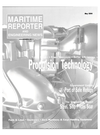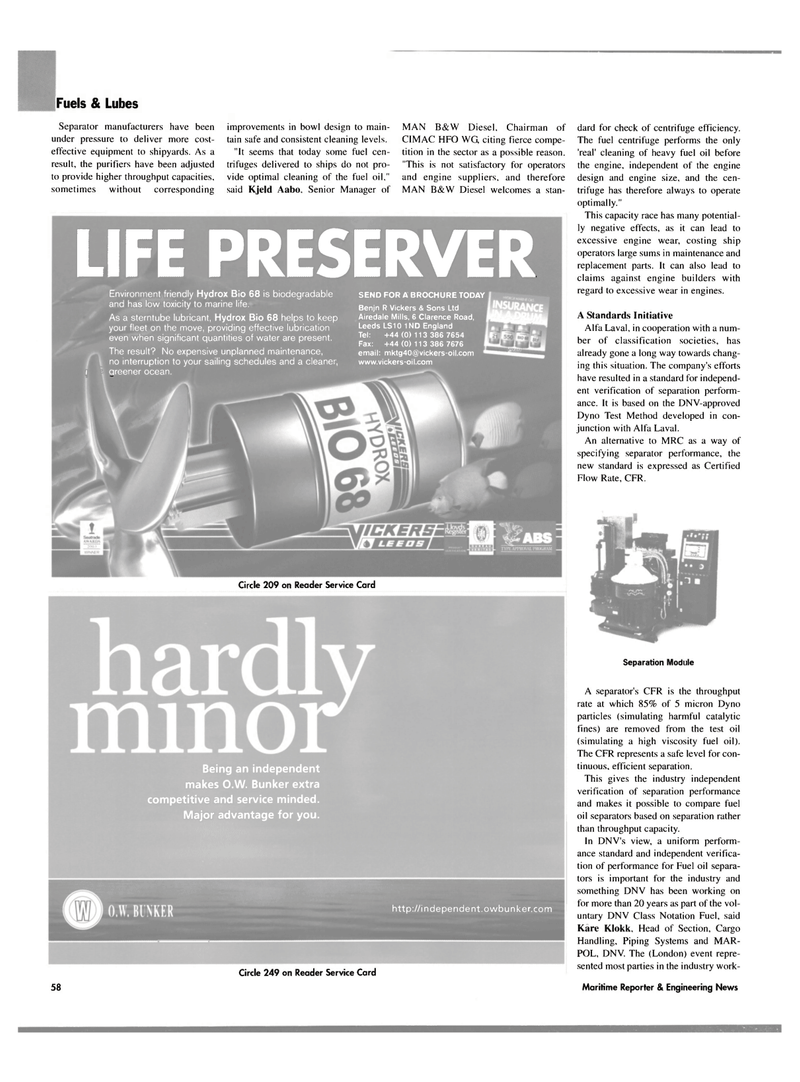
Page 3rd Cover: of Maritime Reporter Magazine (May 2004)
The Propulsion Technology Yearbook
Read this page in Pdf, Flash or Html5 edition of May 2004 Maritime Reporter Magazine
Fuels & Lubes
Separator manufacturers have been under pressure to deliver more cost- effective equipment to shipyards. As a result, the purifiers have been adjusted to provide higher throughput capacities, sometimes without corresponding improvements in bowl design to main- tain safe and consistent cleaning levels. "It seems that today some fuel cen- trifuges delivered to ships do not pro- vide optimal cleaning of the fuel oil," said Kjeld Aabo. Senior Manager of
MAN B&W Diesel. Chairman of
CIMAC HFO WG, citing fierce compe- tition in the sector as a possible reason. "This is not satisfactory for operators and engine suppliers, and therefore
MAN B&W Diesel welcomes a stan-
LIFE PRESERVER
Environment friendly Hydrox Bio 68 is biodegradable and has low toxicity to marine life.
As a sterntube lubricant, Hydrox Bio 68 helps to keep your fleet on the move, providing effective lubrication even when significant quantities of water are present.
The result? No expensive unplanned maintenance, no interruption to your sailing schedules and a cleaner,
I \ greener ocean.
SEND FOR A BROCHURE TODAY
Benjn R Vickers & Sons Ltd
Airedale Mills, 6 Clarence Road,
Leeds LS10 1ND England
Tel: +44(0) 113 386 7654
Fax: +44(0) 113 386 7676 email: [email protected] www.vickers-oil.com
Circle 209 on Reader Service Card
Being an independent makes O.W. Bunker extra competitive and service minded.
Major advantage for you. http://independent.owbunker.com
Circle 249 on Reader Service Card dard for check of centrifuge efficiency.
The fuel centrifuge performs the only 'real' cleaning of heavy fuel oil before the engine, independent of the engine design and engine size, and the cen- trifuge has therefore always to operate optimally."
This capacity race has many potential- ly negative effects, as it can lead to excessive engine wear, costing ship operators large sums in maintenance and replacement parts. It can also lead to claims against engine builders with regard to excessive wear in engines.
A Standards Initiative
Alfa Laval, in cooperation with a num- ber of classification societies, has already gone a long way towards chang- ing this situation. The company's efforts have resulted in a standard for independ- ent verification of separation perform- ance. It is based on the DNV-approved
Dyno Test Method developed in con- junction with Alfa Laval.
An alternative to MRC as a way of specifying separator performance, the new standard is expressed as Certified
Flow Rate, CFR.
Separation Module
A separator's CFR is the throughput rate at which 85% of 5 micron Dyno particles (simulating harmful catalytic fines) are removed from the test oil (simulating a high viscosity fuel oil).
The CFR represents a safe level for con- tinuous, efficient separation.
This gives the industry independent verification of separation performance and makes it possible to compare fuel oil separators based on separation rather than throughput capacity.
In DNV's view, a uniform perform- ance standard and independent verifica- tion of performance for Fuel oil separa- tors is important for the industry and something DNV has been working on for more than 20 years as part of the vol- untary DNV Class Notation Fuel, said
Kare Klokk, Head of Section, Cargo
Handling, Piping Systems and MAR-
POL, DNV. The (London) event repre- sented most parties in the industry work- 58 Maritime Reporter & Engineering News

 61
61

 4th Cover
4th Cover
